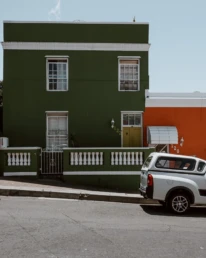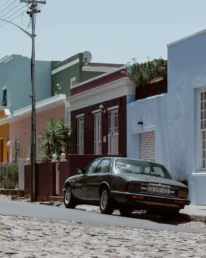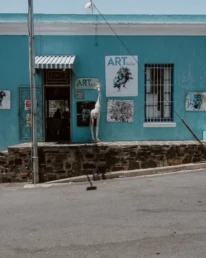The Bo-Kaap, formerly called Schotschekloof, is known for its beautiful colorful house facades. Its history goes back to the 18th century and is characterized by slavery and the faith of Islam.
By: Gate to Paradise | Published: February 11, 2024 | Last Updated: June 11, 2025 | Jump to Comments
On the second day after our arrival, our first trip to South Africa took us to a district that leaves you speechless. All the impressions that hit us at once were incredible. The beautiful house facades with their colorful paintwork, the hustle and bustle and the passion are an experience in themselves.

Did you know? // Residents are not allowed to change the facades of the houses, only the interiors, to preserve the external appearance and historical or aesthetic integrity of the neighborhood. This rule often applies in areas with architectural significance or in planned communities where uniformity is desired to maintain property values and visual appeal.
The Bo-Kaap is located directly on the slope of Signal Hill, which towers dominantly over Cape Town and is only a few hundred meters from the Waterfront as the crow flies.The Bo-Kapp, also known as the Malay Quarter, is only 1 square kilometer in size and was first settled in the 18th century by Cape Malays who were released from slavery.
Routes to Bo-Kaap
The best way to get to the Bo-Kaap, like all other places in Cape Town, is by car. Depending on the time of year/time of day, you will find that it can get a bit hectic when you reach the district. Many people, both locals and tourists, crowd this small place. We recommend that you do not park your car directly on Wale Street, even if you are told to do so by the locals. Unfortunately, you will often be blocked from behind after parking (this also happened to us). When driving away, they will then politely ask you for a donation to clear the way again.Our recommendation is to drive a little further up Wale Street until the houses end. Here on Yusuf Drive there are plenty of parking options away from the hustle and bustle and you can walk down in just 1-2 minutes.
Stick to certain rules of conduct
These are of course not official rules, but rules of etiquette that we think are important to follow. You are not on an Instagram set, but in a residential area and are taking photos of other people’s property.Please treat it with respect. Don’t climb over their walls and fences. From time to time residents will gaze at you from their balconies, please ask them first who they want to take a photo of.


Best things to to in Bo-Kaap
As already mentioned, the neighborhood is quite manageable in size. In addition to the wonderful house facades, you will occasionally see great graffiti art with great meaning for us all. These are always worth a look. Make a detour to the Iziko Bo-Kaap Museum and the cute little stores on the street corners. With a bit of luck, the locals will engage you in an exciting conversation and then invite you on a culinary experience tour of their homes.


The must see streets in Bo-Kaap
Not all streets are really worth walking along. That’s why we’ll briefly show you which ones offer the most beautiful facades and photo spots.
- Wale Street
- Pentz Street
- Upper Leeuwen & Leeuwen Street
- Bryant Street
- Dorp Street
- Van Der Meulen Street
- Chiappini Street
- Helliger Lane
- Rose Street
- Church Street
- Longmarket Street

